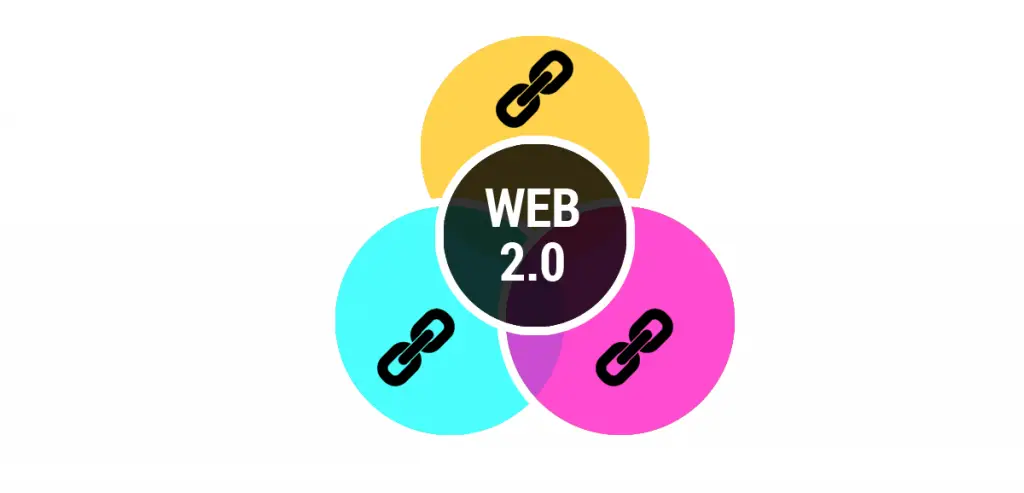In the guide, you’ll learn how to create web 2.0 backlinks to improve your website’s off-page search engine optimization (SEO).
As you’ll discover below, the steps for web 2.0 link building are not difficult to follow; however, you’ll want to ensure you are building this new website property as a valuable digital asset. By building up a strong property using the tips below, you can strengthen the power of your web 2.0 backlinks to pass the most PageRank for SEO during your link building campaigns.
What Is a Web 2.0 Link?
A web 2.0 link is a backlink from self-publishing platforms, social media sites, or any other website that allows user-generated content. Web 2.0 backlinks are a form of link building where you sign up for these sites to build backlinks for SEO purposes.
How to Create Web 2.0 Backlinks for Link Building
1. Sign Up for a Web 2.0 Platform
The first step for how to create web 2.0 backlinks is to sign up for a platform.
The most popular web 2.0 sites to build backlinks on include:
- Blogger
- WordPress
- Wix
- Tumblr
- Weebly
- Sites.Google.com
- Yola
- Medium
- Live Journal
2. Choose the Right Web 2.0 URL
When you create your new web 2.0 site, it will be listed on a sub-domain and not the root domain and you’ll be prompted to give a name for your site’s URL.
This sub-domain part of the URL is where you want to insert your primary keyword. For example:
- keyword.wordpress.com
If you’re building more than one web 2.0 property for backlinks, then you should vary the keyword in your URLs. Don’t repeat the same keyword on each web 2.0 site. Being random in your keyword choices will make your link building appear more natural.
3. Create the Necessary Pages
Every web 2.0 site you create should have four necessary pages: about, contact, terms of use, and privacy policy.
By building these pages, you’ll establish more trust and authority for the web 2.0 site as a whole. Websites that lack these important pages are a red flag that the site cannot be trusted because only untrustworthy sites would not publish this type of information for users to read.
4. Build Up the Web 2.0 Blog
The next step for how to build web 2.0 backlinks is to fill out your blog content.
You’ll want to do this before you move on to step 5 where you’ll actually start placing a backlink to your site.
Publishing 10 to 20 blog posts with unique and in-depth content that all have the same topical relevance will help establish the area of expertise for your new web 2.0 site. It can also help the site get indexed faster in Google, Yahoo, and Bing.
In this other article on creating a topic cluster content strategy for SEO, it explains how you can increase your website’s rankings for a set of keywords by publishing multiple articles around the same topic on your site.
This SEO strategy is also valuable for web 2.0 sites because it helps search engines like Google, Yahoo, and Bing understand what subject area the website is an authority on. So pick a topic and write up to 10 blog posts that are between 500 to 1,000 words each before moving to the next step.
5. Create Your Web 2.0 Backlink
After you’ve published a good number of posts on the blog, you can then create your web 2.0 backlink.
You don’t want to rush this process because it looks unnatural to the ranking algorithms if you were to add your backlink to the first post on your web 2.0 site or immediately on the same day it was created.
Therefore, patience is crucial for this type of link building.
It’s also a good idea to wait until the web 2.0 site has been indexed in Google’s search engine. That way you know for sure that the website is trusted and the URLs are getting crawled and indexed for users to see.
There’s no point in creating a web 2.0 backlink on a site that doesn’t get indexed in the SERPs. So be patient. You want your new links to be permanent and to pass PageRank value to your site for SEO improvements.
As for where you should build the backlink, it can go on a new blog post or be inserted into an existing post that has been indexed in the search engines. Regardless of which method you use for the backlink, you’ll want to follow these three additional tips:
- Follow a good anchor text ratio so you don’t overoptimize your backlink profile.
- Make sure it is a dofollow link to pass PageRank value.
- Add at least 3 to 5 internal links to the page with your backlink to improve internal PageRank authority for the link.
6. Schedule More Articles
Once you add your backlink to the web 2.0 site, you may think you can walk away from it. However, that’s not a good idea for three reasons.
First, web 2.0 platforms are notorious for closing new accounts that don’t publish new content on a regular schedule. These sites will deactivate your account if it seems like you’ve abandoned the site which will lead to a loss of that backlink.
Second, you want to improve the overall strength of the web 2.0 site by attracting organic visitors and increasing the PageRank authority for the page that contains your link. And you can only do that by continually adding new content and creating more internal links to the target page with the backlink.
Third, web 2.0 sites with thin content and/or only a few pages are considered spammy and may be discounted by Google’s algorithm or worse, cause a ranking penalty. In a Google Webmaster Office Hours Hangout with John Mueller, Google Webmaster Trends Analyst, was asked about getting links from free posting sites.:
“How effective is old off page SEO like backlinks creation? Many agencies spend lots of time doing old off page activities such as image sharing with links, article submission on sites like Tumblr, classified sites and other free posting sites where people hardly read any of the posts but those platforms for dropping links with some text basically majority of their site has poor quality posts.”
Part of John Mueller’s response was:
“That’s not going to help your website, that’s just going to considered as spam so that’s a really bad idea.”
Based on all of this, you should treat your web 2.0 sites just like any other website you own; by publishing new articles on a regular basis and making them valuable online assets that are worth being indexed in Google.
At a bare minimum, you should schedule 1 new article to be released per month to keep the account active. And if you’re really serious about building up the PageRank authority for this site, then authoring 1 to 2 new blog posts per week can be a major benefit to increasing that authority.
7. Build Backlinks to Your Web 2.0 Site
Another step you should take after creating web 2.0 backlinks is to build links to your web 2.0 properties.
Your goal for building these types of links should be to make them as powerful as possible for SEO and ranking purposes. And to do that, you’ll need to create high-quality backlinks to the homepage and individual page that your link is placed on.
You can read this guide on how to build backlinks for free and follow the steps in this other post on how to get high quality backlinks to power up your web 2.0 sites for SEO.
You can also use these free backlink analysis tools to scan your website’s backlink profile to find out when these new links have been discovered for indexing and ranking purposes.
8. Share the Content to Create More Links
After you’ve finished creating your web 2.0 site, and built some quality dofollow links to it, the final step in the process is to share the content from those sites on the Internet to generate even more quality links.
Building a good web 2.0 site takes a lot of time and effort and you should let the world know about the articles you’ve published on the site to increase the organic traffic and number of natural backlinks.
A good strategy here is to create a variety of social media accounts and publish links to each individual page on the web 2.0 site. You can also repurpose any graphics you’ve used in the blog posts or take snippets of text to produce endless amounts of new content for these social media accounts.
Essentially, you want to continue getting new visitors to the web 2.0 sites so the articles can get their own backlinks and shares on social media to improve the PageRank value for SEO. You should be treating these web 2.0 properties like they’re one of your most important assets and not something that’s created once and then left alone.
How Many Web 2.0 Backlinks Should I Build?
You should build 5 to 10 web 2.0 backlinks from different platforms in addition to other link building methods. Web 2.0 backlinks should only be a small part of your backlink profile and not comprise the entire list of referring domains.
Are Web 2.0 Backlinks Good for SEO?
Web 2.0 backlinks are good for SEO because they can help diversify a website’s backlink profile. High quality web 2.0 backlinks are also the most cost-effective links to use on low to medium competition keywords to improve their rankings in the search engines.
Including web 2.0 sites as part of an SEO link building strategy can be beneficial for new websites that don’t have the budget or ability to acquire high quality links. However, their impact on off-page SEO and transferring PageRank value is limited based on the popularity and strength of the web 2.0 property itself.

Summary for Web 2.0 Backlinks & Link Building Guide
I hope you enjoyed this guide on how to create web 2.0 backlinks.
As you discovered, the process for web 2.0 link building is quite simple, but the key to having success with these types of backlinks for SEO is to make those properties valuable digital assets that can provide long-term PageRank value. The more time and effort you put into these web 2.0 sites, the more powerful the backlinks will be for your link building campaigns.

SEO Chatter is dedicated to teaching the fundamentals of search engine marketing to help marketers understand how to increase organic website traffic and improve search engine rankings.


